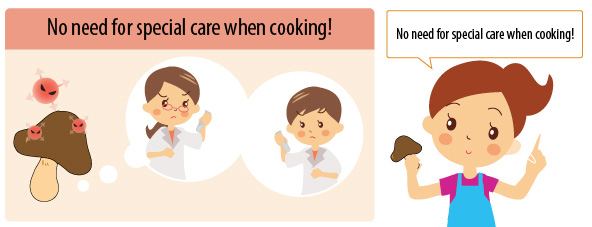Tokyo Food Safety Information Center » Tokyo Metropolitan Government food safety FAQ »Are there any foods that contain large amounts of radioactive substances?
Are there any foods that contain large amounts of radioactive substances?

Are there any foods that contain large amounts of radioactive substances?
- Don’t radioactive substances become concentrated and accumulate in food?
- Can radioactive substances be reduced by washing or boiling?
- Can radioactive substances be reduced by boiling tap water?

The frequency and volume of testing are increased for foods in which large amounts of radioactive substances are likely to be detected to ensure that they are not in circulation. For example, it is known that wild mushrooms easily take up radioactive substances, so various types of wild mushrooms are tested in each area during the mushroom harvesting period.
Basically, there is no need to take any special care when cooking because the radioactive substances contained in food are below the limit values in food that is in circulation.


The ease of transfer of radioactive substances from the soil into vegetables and so on varies depending on the nature of the plant, the constituents and properties of the soil in fields, etc. fertilizers and other factors.
It is known that radioactive cesium accumulates in high concentrations in mushrooms. Because mushrooms absorb radioactive substances from mushroom logs, farmers who cultivate mushrooms control the growing environment through such means as reducing the amount of radioactive substances contained in mushroom logs.
Meanwhile, depending on the area, high values of radioactive substances can be detected in produce harvested from mountains and rivers that cannot be decontaminated.
In addition, edible wild plants, game such as wild boar, and river fish take in radioactive substances from the soil and bait.
To ensure food that exceeds the limit values is not in circulation, each prefecture inspects the food produced in the area to ascertain the situation. Measures such as shipment restrictions are taken for food that exceeds the limit values taking into account the regional spread. You can check the detection of radioactive substances in food on the websites of the Ministry of Health, Labour and Welfare and each local government. Refer to “What kind of tests are carried out on radioactive substances in food and what kind of results do they produce?” for the details.
It is possible to reduce radioactive substances depending on the method of cooking. For example, it is known that radioactive cesium contained in food is halved by boiling. However, radioactive substances transfer into the cooking liquid. Radioactive substances are not reduced by heating.
It has also been reported that 65% of radioactive substances are removed from rice when it is polished.
When tap water is boiled, the water evaporates, and any radioactive substances can be conversely concentrated. Tokyo Metropolitan Government measures the radioactive substances contained in treated water (tap water) at the major water purification plants every day. At present, radioactive substances from the accident have not been detected in treated water at any water purification plant and are below the limit value for drinking water (10 becquerel/kg). You can check the test results on the page below.
・Bureau of Waterworks Tokyo Metropolitan Government:Measurement results for radioactive substances in treated water (tap water) and raw water
There are currently no foods that are scientifically proven to be able to reduce radioactive substances in the body.